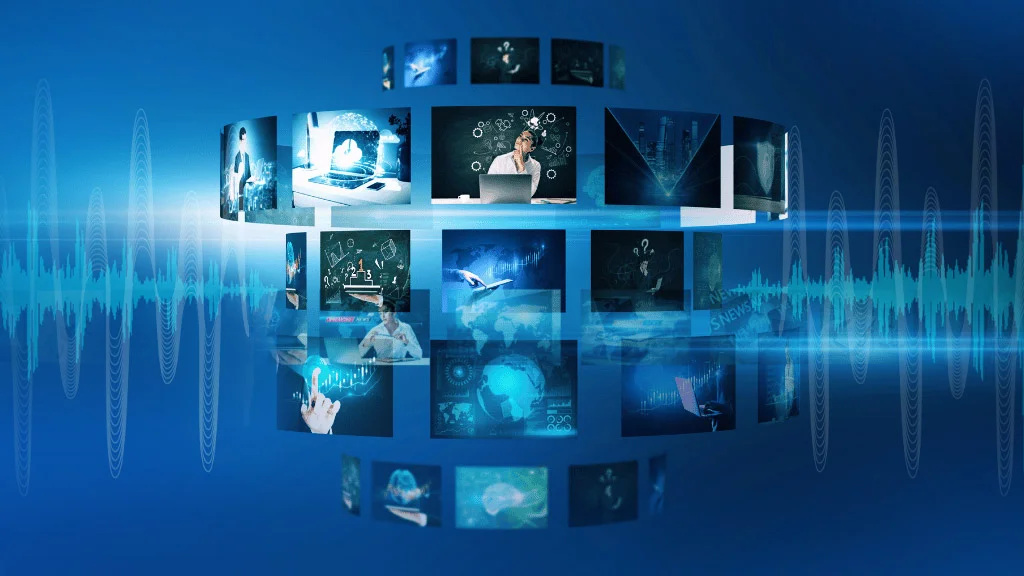
- Article
Digital Signal Processing In Broadcast Industry
Since the very first Radio/TV broadcast production in analog platforms, Signal Processing has always been an important consideration. Through years and decades, broadcast systems transformed into digital and changed the models of audio/video signal processing procedures.
Now Digital Signal Processing is an essential component in modern production and broadcast studios. It involves the manipulation and analysis of digital signals, such as audio and video, to enhance their quality, reduce noise, and enable advanced features.
The adoption of DSP in the broadcast industry has enabled broadcasters to deliver higher-quality programs in addition to more efficient services to their audience. As technology continues to evolve, further advancements in DSP would undoubtedly shape the future of the broadcast industry.
What is digital signal processing?
Digital signal processing refers to the mathematical manipulation and analysis of digital signals, which are discrete-time signals or sequences of numbers representing the amplitude of an analog signal at discrete points in time. The conversion of an analog signal to a digital signal is a crucial step in modern digital signal processing and broadcast workflows. This process is known as analog-to-digital conversion (ADC) and involves several key steps:
- Sampling:
The analog signal is sampled at a specific rate, known as the sampling rate, which determines the number of samples taken per second. The sampling rate must be at least twice the highest frequency present in the analog signal to avoid aliasing.
- Quantization:
Each sampled value is quantized, or rounded, to the nearest discrete digital value.
The number of possible digital values is determined by the bit depth, which typically ranges from 8 to 24 bits or more. Higher bit depths provide more precise representation of the original analog signal.
- Encoding:
The quantized digital values are then encoded into a digital data stream, which can be stored or transmitted.
Common digital audio formats include PCM (Pulse-Code Modulation), FLAC (Free Lossless Audio Codec), and MP3 (MPEG-1 Audio Layer III).
For digital video, common formats include uncompressed formats like SDI (Serial Digital Interface) and compressed formats like H.264 and HEVC.
In broadcast studios, the conversion from analog to digital is often performed using dedicated analog-to-digital converter (ADC) hardware, which can provide high-quality, low-latency conversion with precise timing and synchronization.
Read also :
Media Broadcast Advantages
Advantage of digital signal processing
Here are the key advantage of digital signal processing :
- Flexibility and Programmability:
DSP systems can be easily reprogrammed or reconfigured to perform different tasks, providing greater flexibility compared to analog systems.
The algorithms and processing can be updated or modified to adapt to changing requirements or new applications.
- Precision and Accuracy:
Digital operations can be performed with a high degree of precision, as the numerical representation and computations are not subject to the same limitations as analog systems.
DSP systems can achieve better signal-to-noise ratios and lower distortion levels compared to analog systems
- Noise Immunity:
Digital signals are less susceptible to noise, interference, and signal degradation during transmission and processing.
these techniques, such as digital filtering and error correction, can effectively remove or mitigate the effects of noise and distortion.
- Efficient Storage and Transmission:
Digital signals can be efficiently stored and transmitted, which is a significant advantage of digital signal processing, enabling applications such as digital audio, video, and data communications.
Compression algorithms used in DSP can significantly reduce the storage and bandwidth requirements for digital data.
- Scalability and Integration:
DSP systems can be easily scaled to handle increasing computational demands or to accommodate technological advancements.
- Power Efficiency:
these algorithms can be designed to be computationally efficient, often requiring less power compared to analog counterparts.
This makes DSP well-suited for battery-powered and energy-constrained applications.
- Enhanced Signal Processing Capabilities:
DSP enables the implementation of advanced signal processing techniques, such as adaptive filtering, spectral analysis, and digital beamforming.
These techniques can achieve performance levels that are difficult or impossible to replicate with analog systems.
- Cost-Effectiveness:
The mass production and miniaturization of digital electronics have led to the development of cost-effective DSP hardware and software solutions.
These advantages have made digital signal processing a fundamental technology in a vast array of applications.

Role of DSP in Audio Processing
In broadcast industry, DSP plays a vital role in various aspects of audio processing and the supporting broadcast equipment:
Audio Mixing and Routing:
DSP-powered digital audio mixers allow for precise control over multiple audio channels, including levels, EQ, dynamics processing, and effects.
Advanced DSP algorithms enable complex audio routing, matrix mixing, and bus-based signal routing in broadcast consoles and routers.
- Audio Enhancement and Effects:
DSP is used to implement various audio processing algorithms, such as compression, limiting, gating, and expansion, to control and shape the dynamic range of audio signals.
Digital reverb, delay, and other spatial effects are achieved through DSP-powered algorithms, allowing for the creation of unique sound environments.
Noise reduction, de-essing, and other advanced audio cleanup techniques rely on DSP to identify and remove unwanted artifacts.
- Multichannel and Surround Sound:
DSP is essential for the processing and encoding of multichannel audio formats, such as 5.1 or 7.1 surround sound, used in modern broadcast productions.
This includes efficient downmixing, upmixing, and channel-based processing to maintain audio integrity and spatial coherence.
- Loudness and Dynamic Range Control:
DSP-based loudness meters and processing algorithms help broadcast engineers maintain compliance with industry standards and regulations for audio levels and dynamic range.
This ensures a consistent and optimized audio experience for viewers across different devices and environments.
- Audio Encoding and Transcoding:
DSP is used to implement audio codecs, such as AAC, Dolby Digital, and MPEG-1 Layer II, which are essential for efficient audio compression and transmission in broadcast workflows.
Real-time transcoding between different audio formats and sample rates is often handled by DSP-powered hardware and software solutions.
- Synchronization and Timing:
DSP plays a crucial role in maintaining precise time synchronization between audio, video, and other broadcast signals, ensuring proper lip-sync and frame-accurate timing.
The integration of DSP technologies into broadcast audio equipment, such as mixers, processors, and encoders, allows for advanced signal processing, sophisticated audio control, and seamless integration within the broader broadcast production.
As broadcast technologies continue to evolve, the role of DSP will only become more prominent in delivering high-quality, immersive audio experiences for viewers and listeners.

Role of DSP in Video Processing
DSP plays a crucial role in various aspects of video processing and the supporting broadcast equipment:
- Video Format Conversion and Scaling:
DSP algorithms enable the conversion between different video formats, resolutions, and frame rates, ensuring compatibility and seamless integration in broadcast workflows.
DSP-powered video scalers and de-interlacers allow for high-quality upscaling, downscaling, and format conversion of video signals.
- Image Enhancement and Color Correction:
DSP is used to implement advanced image processing algorithms for color correction, white balance adjustment, and tone mapping.
These DSP-driven techniques help to improve the visual quality, color fidelity, and overall aesthetics of video content.
- Motion Processing and Stabilization:
DSP-based algorithms are employed to analyze and process video frames, enabling features like motion-adaptive noise reduction, video stabilization, and motion-compensated frame interpolation.
These techniques help to reduce artifacts, improve visual smoothness, and compensate for camera shake or other motion-related issues.
- Video Effects and Compositing:
DSP powers the implementation of various video effects, such as chroma keying, green screen compositing, and visual effects.
Advanced DSP algorithms facilitate the seamless integration of multiple video layers, graphics, and special effects within a single video stream.
- Video Compression and Encoding:
DSP is essential for the implementation of video codecs, such as H.264, HEVC, and AV1, which enable efficient compression and transmission of video content.
Real-time video encoding and transcoding are often handled by dedicated DSP-powered hardware and software solutions.
- Video Synchronization and Timing:
DSP plays a critical role in maintaining precise synchronization between video, audio, and other ancillary signals, ensuring accurate lip-sync and frame-accurate timing.
- Video Analytics and Processing:
DSP can be used to power advanced video analytics, such as object detection, facial recognition, and scene analysis, which are increasingly important in broadcast and media applications.
The integration of DSP technologies into broadcast video equipment, such as cameras, switchers, encoders, and playout servers, enables high-quality video processing, advanced features, and seamless integration within the overall broadcast infrastructure.

Implementation of DSP in Broadcast Equipment
Digital signal processing (DSP) is extensively used in the implementation of various broadcast equipment and systems. Here are some examples of how DSP is implemented in broadcast equipment:
- Audio Mixers and Consoles:
DSP is used for digital signal routing, mixing, and processing of audio signals.
This includes features like digital equalization, dynamic range compression, and effects processing (e.g., reverb, delay and chorus).
DSP-based mixing consoles offer advanced capabilities like automation, scene recall, and integration with digital audio workstations.
- Video Switchers and Production Engines:
DSP is employed for real-time video processing, such as video scaling, format conversion, and transition effects.
DSP-based video switchers enable seamless switching between multiple video sources and the application of various visual effects.
Advanced production engines leverage DSP to handle complex video processing tasks, including chroma keying, graphics overlay, and video compositing.
- Multiviewer
Multiviewer systems are essential components in broadcast control room and production facilities, allowing operators to monitor and manage multiple video and audio sources simultaneously on a single display. DSP is used to process and scale multiple video inputs with different resolutions, frame rates, and video formats to a common format for display on the Multiviewer. This involves DSP-powered video format conversion, scaling, and synchronization algorithms to ensure seamless integration of the various video sources.
- Intercom systems:
DSP is used to handle the processing of audio signals within the intercom system, including microphone input conditioning, noise reduction, echo cancellation, and audio mixing. This ensures clear, high-quality digital audio communication between intercom users, even in noisy production environments.
- Video Signal Processors:
DSP is employed in specialized video processing units for tasks like video stabilization, noise reduction, color correction, and image enhancement.
Each DSP-based video processor is integrated into cameras, monitors, digital displays, and other broadcast equipment to improve the visual quality of video content.
- Broadcast Routing and Distribution Systems:
DSP is used for the routing, switching, and distribution of audio and video signals across complex broadcast infrastructures.
DSP-based routing matrices and distribution amplifiers enable the seamless integration and management of multiple audio and video sources.
- Broadcast Automation and Control Systems:
DSP is utilized in the implementation of broadcast automation and control systems that manage and coordinate the various broadcast equipment and workflows.
DSP-powered control systems enable the automation of tasks like playlist management, device control, and live event production.
The integration of DSP technologies in broadcast equipment has played a crucial role in enabling the advanced capabilities, flexibility, and efficiency of modern broadcast systems, contributing to the evolution of the broadcast industry to the next level of practice and efficiency.









